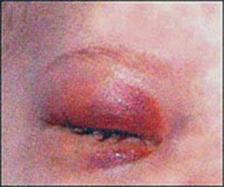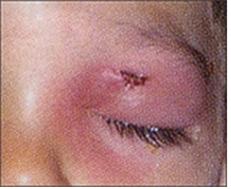안와 주위 봉소염(안구 주위염) Periorbital cellulitis (Preseptal cellulitis)
- 안구를 둘러싸고 있는 연조직 부분을 안와 조직이라고 한다.
- 안구에는 감염이 생기지 않고 다만 안와(눈꺼풀)에 있는 연조직과 눈꺼풀에 박테리아 감염이 생기고 안와 주위의 연조직과 눈꺼풀이 곪는 감염병을 안와 주위 봉소염이라고 한다.
- 즉 눈꺼풀과 안와 주위 봉소염을 일으킨 박테리아가 안와 주위 연조직뿐만 아니라 두개강 속에 있는 정맥과 두개강 내 뇌 및, 또는 뇌막, 또는 그 밖의 다른 뇌 부위까지 감염돼서 그 부위에 염증을 일으킬 수 있다.
- 안와 주위 봉소염을 적절히 치료하지 않으면 시력은 물론이고 생명을 잃을 수 있다.
안와 주위 봉소염(안구 주위염)의 원인
-
패혈증을 일으킨 박테리아가 안구 주위 연조직으로 감염되면 안와 주위 봉소염이 생길 수 있다.
-
박테리아가 안구나 눈 주위 연조직에 생긴 타박상이나 열상, 안검 열상, 눈 다래끼, 결막염, 곤충 자상, 누낭염 등을 통해 안구 주위 연조직에 감염될 때, 사골동 등의 부비동염을 일으킨 박테리아가 안구 주위 연조직이나 안검(눈꺼풀)으로 감염될 때, 박테리아 결막염을 적절히 치료해 주지 않았을 때, 또는 그 외 다른 경우 안와 주위 봉소염이 생길 수 있다.
-
이 병을 일으킬 수 있는 박테리아는 여러 종류가 있지만 황색 포도상구균, A군 베타 용혈성 연쇄상구균, 폐렴연쇄상 구균, 또는 B형 헤모필러스 인플루엔자균(히브균) 등이다.

사진 87. 안와 주위 봉소염(안구 주위염)
소스-infectious diseses in children, August 2005, p 60

사진 88. 안와 주위 봉소염(안구 주위염)
소스-infectious diseses in children, August 2005, p 60
안와 주위 봉소염(안구 주위염)의 증상 징후
-
이 병의 원인, 정도, 합병증의 유무 등에 따라 증상 징후가 다르다.
-
경미할 때는 눈꺼풀이 붓고 눈이 빨갛다.
-
안구 주위 연조직와 눈꺼풀이 심하게 붓고 눈이 빨개진다.
-
안구 주위가 아프고 미열 내지 고열이 날 수 있다.
-
눈꺼풀과 안구 주위가 심하게 부을 때는 눈을 잘 뜰 수 없다.
-
고름이 눈에서 조금 나올 수 있다.
-
이 병을 속히 적절히 치료해 주지 않으면, 이 병을 일으킨 박테리아가 두개강 내로 계속 퍼져서 뇌 정맥염, 뇌막염, 또는 뇌 농양 등이 생길 수 있고, 그 쪽 시력을 잃을 수도 있다.
안와 주위 봉소염(안구 주위염)의 진단
-
병력, 증상 징후와 진찰소견 등을 종합하고 안구 초음파 검사나 X-선 사진 검사 등으로 진단한다.
-
채취한 고름으로 그람 염색 현미경 세균검사와 세균배양검사 등으로 원인균을 알아낸다. 부모도 반의사가 되어야 한다–소아가장간호 백과 제18권 소아청소년 이비인후과 질환–급성 축농증 참조.
안와 주위 봉소염(안구 주위염)의 치료
-
이 병이 의심되면 입원하여 안와 주위 봉소염에서 나온 고름을 피 검물로 조금 채취한 후 우선 적절한 항생제 정맥주사로 치료를 시작한다.
-
그람 역색 현미경 검사도 하고 세균 배양검사도 하고 항균제 감수성 검사를 해서 그 균에 가장 잘 듣는 항생제 혈관주사로 치료한다.
-
드물게는 안구 주위 연조직에 고인 고름을 수술로 배농해야 할 때도 있다.
-
축농증을 일으킨 박테리아가 안와 주위에 감염돼서 안와 주위 봉소염이 생겼을 때는 안와 주위 봉소염과 축농증을 동시 치료해야 한다.
-
맨 처음에는 안와 주위염만 있던 것이 안와 봉와직염으로 진전될 수 있다.
Periorbital cellulitis (Preseptal cellulitis) 안와 주위 봉소염(안구 주위염)
• The area of soft tissue surrounding the eyeball is called orbital tissue.
• Infectious disease in which no infection occurs in the eyeball, but bacterial infection occurs in the soft tissues and eyelids in the orbit (eyelids), and the soft tissues and eyelids around the orbit become chapped, called periorbital cellulitis.
• In other words, the bacteria that cause eyelid and periorbital cellulitis can infect not only the soft tissues around the orbit, but also the veins in the cranial cavity, the brain in the cranial cavity and/or the meninges, or other parts of the brain, causing inflammation in those areas.
• Periorbital cellulitis can be life-threatening if not properly treated. Causes of cellulitis (periorbital) around the orbit
• Periorbital cellulitis can occur when the sepsis-causing bacteria infects the soft tissue around the eyeball.
• When bacteria infect the soft tissues around the eye through bruises or lacerations, eyelid lacerations, eye styes, conjunctivitis, insect bites, or dacryocystitis, bacteria that cause sinusitis such as the ethmoid sinuses Periorbital cellulitis can occur when the eyelids (eyelids) become infected, when bacterial conjunctivitis is not properly treated, or in other cases.
• There are several types of bacteria that can cause this disease, but include Staphylococcus aureus, group A beta-hemolytic streptococci, Streptococcus pneumoniae, or Haemophilus influenzae type B (H. pneumoniae).

Photo 87. Periorbital cellulitis (periorbital) Sources – infectious disseses in children, August 2005, p 60

Photo 88. Periorbital cellulitis (periorbital) Sources – infectious disseses in children, August 2005, p 60
Signs, symptoms of periorbital cellulitis (Preseptal cellulitis)
• Symptoms and signs vary depending on the cause, severity, and presence or absence of complications.
• In mild cases, the eyelids are swollen and the eyes are red.
• Severe swelling of the soft tissues around the eyes and eyelids, and redness of the eyes.
• The area around the eyes hurts and you may have a slight or high fever.
• When the eyelids and around the eyeballs are very swollen, it is difficult to open the eyes.
• A small amount of pus may come out of the eye.
• If this disease is not treated promptly and properly, the bacteria that cause this disease may continue to spread into the cranial cavity, resulting in cerebral phlebitis, meningitis, or brain abscess, and loss of vision in that area.
Diagnosis of periorbital cellulitis (Preseptal cellulitis)
• Diagnosis is made by synthesizing the medical history, symptom signs, and examination findings, and ocular ultrasonography or X-ray examination.
• With the collected pus, the causative bacteria are identified by bacteriological examination under a Gram-stained microscope and bacterial culture examination.
www.drleepediatrics.com Vol. 18 Children’s and Adolescent Otolaryngology Diseases-Acute Sinusitis.
Treatment of periorbital cellulitis
• If this disease is suspected, hospitalize and collect a small amount of pus from cellulitis around the orbit as a blood sample, and then start treatment with an appropriate antibiotic intravenous injection.
• Gram inverse microscopy, bacterial culture, and antimicrobial susceptibility tests are performed, and treatment is performed with intravenous antibiotic injections that are most effective against the bacteria.
• In rare cases, it may be necessary to surgically drain the pus from the soft tissue around the eyeball.
• When cellulitis is caused by infection around the orbit with the bacteria causing sinusitis, it is necessary to treat both cellulitis and sinusitis at the same time.
• What may initially be only par orbital infection can progress to orbital cellulitis.
출처 및 참조문헌
- www.drleepediatrics.com 제 6권 신생아 성장 발육 육아 질병
-
www.drleepediatrics.com제7권 소아청소년 감염병
- www.drleepediatrics.com제8권 소아청소년 호흡기 질환
- www.drleepediatrics.com제9권 소아청소년 소화기 질환
- www.drleepediatrics.com제10권. 소아청소년 신장 비뇨 생식기 질환
- www.drleepediatrics.com제11권. 소아청소년 심장 혈관계 질환
- www.drleepediatrics.com제12권. 소아청소년 신경 정신 질환, 행동 수면 문제
- www.drleepediatrics.com제13권. 소아청소년 혈액, 림프, 종양 질환
- www.drleepediatrics.com제14권. 소아청소년 내분비, 유전, 염색체, 대사, 희귀병
- www.drleepediatrics.com제15권. 소아청소년 알레르기, 자가 면역질환
- www.drleepediatrics.com제17권. 소아청소년 피부 질환
- www.drleepediatrics.com제18권. 소아청소년 이비인후(귀 코 인두 후두) 질환
- www.drleepediatrics.com제19권. 소아청소년 안과 (눈)질환
- Red book 29th-31st edition 2021
- Nelson Text Book of Pediatrics 19th — 21st Edition
- The Johns Hopkins Hospital, The Harriet Lane Handbook, 22nd edition
-
Childhood Emergencies in the Office, Hospital and Community, American Academy of Pediatrics
-
Emergency Medical Service for Children, By Ross Lab. May 1989. p.10
-
Emergency care, Harvey grant, and Robert Murray
-
Emergency Care Transportation of Sick and Injured American Academy of Orthopaedic Surgeons
-
Emergency Pediatrics A Guide to Ambulatory Care, Roger M. Barkin, Peter Rosen
-
Immediate care of the acutely ill and injured, Hugh E. Stephenson, Jr
-
The Critically Ill Child, Diagnosis and Management, Edited by Clement A. Smith
-
Emergency Medical Services for Children: The Role of the Primary Care Provider, America Academy of Pediatrics
-
Quick Reference To Pediatric Emergencies, Delmer J. Pascoe, M.D., Moses Grossman, M.D. with 26 contributors
-
Manual of Emergency Care
-
응급환자관리 정담미디어
-
소아가정간호백과–부모도 반의사가 되어야 한다, 이상원
-
Neonatal Resuscitation American heart Association
-
Neonatology Jeffrey J.Pomerance, C. Joan Richardson
-
Pediatric Resuscitation Pediatric Clinics of North America, Stephen M. Schexnayder, M.D.
-
Pediatric Critical Care, Pediatric Clinics of North America, James P. Orlowski, M.D.
-
Preparation for Birth. Beverly Savage and Dianna Smith
- Infectious disease of children, Saul Krugman, Samuel L Katz, Ann A. Gershon, Catherine Wilfert
-
The Harriet Lane Handbook 19th Edition
-
소아과학 대한교과서
-
제1권 소아청소년 응급의료 참조문헌과 출처
-
Other
Copyright ⓒ 2015 John Sangwon Lee, MD., FAAP
“부모도 반의사가 되어야 한다”-내용은 여러분들의 의사로부터 얻은 정보와 진료를 대신할 수 없습니다.
“The information contained in this publication should not be used as a substitute for the medical care and advice of your doctor. There may be variations in treatment that your doctor may recommend based on individual facts and circumstances. “Parental education is the best medicine.”